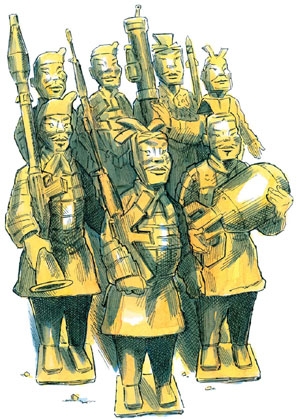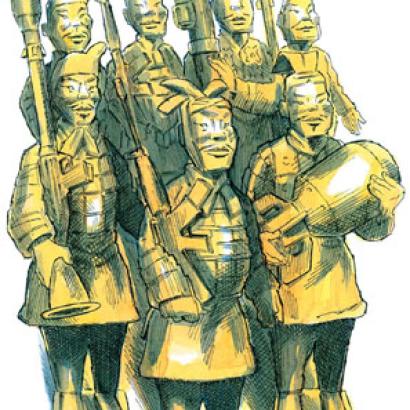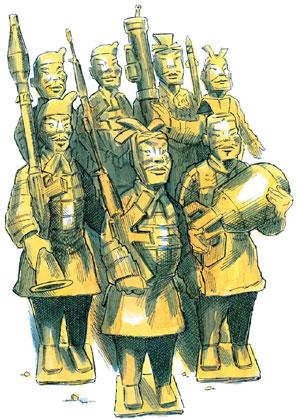- Economics
- International Affairs
- US Foreign Policy
- Law & Policy
- Civil Rights & Race
China’s emergence as an economic power has set off alarms among national security and military experts in Washington. They point to China’s rapidly rising military expenditures, including the acquisition of world-class submarines and its development of a blue-water navy, modern aircraft, satellite launch and destruction capability, a broad range of missiles, and a more professional army. Taiwan’s security is an immediate concern, but the longer-term threat lies in China’s growing influence throughout Asia and its quest for natural resources in Africa and Latin America. What, then, should U.S. policy be toward China?
Let’s begin with China’s economy. Economic restructuring began in earnest in 1978, when Deng Xiaoping established the rural household responsibility system, which was followed by a transformation in industrial production. The economy has turned in a 10 percent annual average real growth rate for 28 years (11 percent in the past few years). This rate of growth doubles real national income every 7 to 8 years, quadruples it in 14–15 years, increases it eightfold in 22–23 years, and so on. People in Chinese coastal cities already enjoy comfortable middle-class living standards. In terms of purchasing power parity (PPP), China’s economy is now the world’s second largest, valued at $10 trillion, fast approaching the $13 trillion U.S. economy. Princeton professor Gregory Chow, an expert on China’s economy, projects a sustained 9–10 percent growth rate through 2020. At that rate, China’s economy would catch up to the United States by 2011–12.

Chinese statistics on M2 growth, the broad measure of the Chinese money supply, have been available on a common standard since 1994. In 1994–2006, M2 growth averaged 19 percent. In dollar terms, an M2 of 34.6 trillion yuan (the Chinese unit of currency) on December 31, 2006, amounted to $4.48 trillion. Assuming Chow’s projection of 9–10 percent growth through 2020, and an M2 annual growth of 17 percent, China’s M2 will reach $9 trillion in 2010 (the current U.S. M2 is about $7 trillion), $18 trillion in 2014, and so on. The U.S. dollar value of China’s M2 will exceed U.S. M2 by 2012. (The yuan appreciated from 8.28 to the dollar in July 2005 to 7.56 in July 2007.)
China has amassed more than $1.3 trillion in foreign exchange reserves, the largest in the world, and continues to accumulate tens of billions every month. During 1995–2006, China’s foreign reserves rose at an annual average rate of 20 percent. Several important strategic issues arise from China’s vast holdings of U.S. government securities.
Government revenues in China are extremely elastic with respect to growth. Revenue rose 20–22 percent in 2005 and 2006. More economic activity than before is subject to taxation, which means that the government is collecting an increasing share of national output, investing those funds in infrastructure and strengthening its military forces.
Of course, M2 is not the sole measure of a country’s financial wealth. A more comprehensive indicator is household savings, which includes equities, bonds, insurance policies, and other financial and real assets. Compared with the United States—apart from traditional savings, money creation, and intermediation by China’s banking system—China’s other financial markets are still emerging. Excluding real estate, the value of all U.S. household private net wealth is around $29 trillion, four times the U.S. M2. The comparable figure for China is far less, but the value of non-M2 Chinese financial assets will rise rapidly as China’s financial markets develop.
These numbers portend that within a decade or two, the Chinese people will own the world’s largest percentage of real household wealth. Rising tax revenues of 20 percent a year will transfer an ever-increasing share of this wealth to the Chinese government, giving it enormous economic, political, and military power.
This economic reality worries strategic planners. Should the United States take a path of confrontation or seek out a path of cooperation? In my view, our mutual interests provide an enormous opportunity that should be pursued. China’s overriding objective is to maintain a strong economy, provide 25 million new jobs a year, and upgrade living standards. To do this, China requires global economic and political stability. The United States shares those goals. Both nations have a stake in maintaining peace and curtailing terrorism.
Over time, the U.S. share of global output and U.S. influence will gradually decline. China, India, Brazil, Russia, and other rapidly growing economies will make everyone better off, including Americans, but also give those countries a larger role in international affairs. China needs U.S. markets, and the United States will increasingly need China’s markets as its economy continues to expand. What is needed, then, is a new global security framework, a worldwide Monroe Doctrine, that can take the form of U.S. responsibility for stability in the Western Hemisphere, with China and India assuming greater responsibility for stability in Asia. Trade and other mutually beneficial relationships between the United States and China can build cooperation across the oceans.
Although much of U.S. security policy is focused on Iraq and the Middle East, we must not neglect the dramatic global change that is reflected in China’s remarkable economic transformation. It is time for serious thinking and strategic dialogue between China and the United States aimed at developing a cooperative relationship in trade, politics, and military affairs, rather than treating China’s growing prosperity and military power as a threat.
















